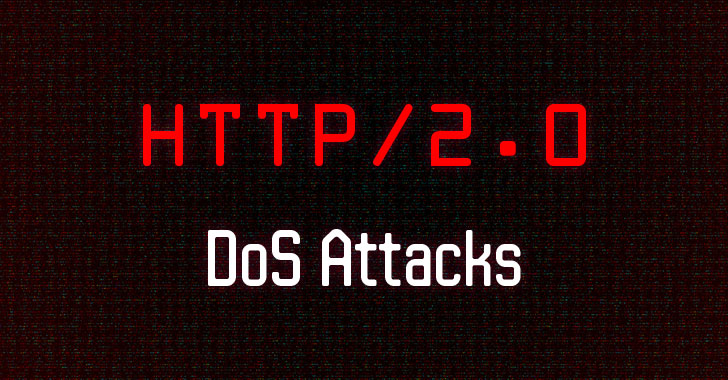8 New HTTP/2 Implementation Flaws Expose Websites to DoS Attacks
Various implementations of HTTP/2, the latest version of the HTTP network protocol, have been found vulnerable to multiple security vulnerabilities affecting the most popular web server software, including Apache, Microsoft's IIS, and NGINX.
Launched in May 2015, HTTP/2 has been designed for better security and improved online experience by speeding up page loads. Today, over hundreds of millions of websites, or some 40 percent of all the sites on the Internet, are running using HTTP/2 protocol.
A total of eight high-severity HTTP/2 vulnerabilities, seven discovered by Jonathan Looney of Netflix and one by Piotr Sikora of Google, exist due to resource exhaustion when handling malicious input, allowing a client to overload server's queue management code.
The vulnerabilities can be exploited to launch Denial of Service (DoS) attacks against millions of online services and websites that are running on a web server with the vulnerable implementation of HTTP/2, knocking them offline for everyone.
The attack scenario, in layman's terms, is that a malicious client asks a targeted vulnerable server to do something which generates a response, but then the client refuses to read the response, forcing it to consume excessive memory and CPU while processing requests.
Most of the below-listed vulnerabilities work at the HTTP/2 transport layer:
"Some are efficient enough that a single end-system could potentially cause havoc on multiple servers. Other attacks are less efficient; however, even less efficient attacks can open the door for DDoS attacks which are difficult to detect and block," the advisory states.
However, it should be noted that the vulnerabilities can only be used to cause a DoS condition and do not allow attackers to compromise the confidentiality or integrity of the data contained within the vulnerable servers.
Netflix security team, who teamed up with Google and CERT Coordination Center to disclose the reported HTTP/2 flaws, discovered seven out of eight vulnerabilities in several HTTP/2 server implementations in May 2019 and responsibly reported them to each of the affected vendors and maintainers.
According to CERT, affected vendors include NGINX, Apache, H2O, Nghttp2, Microsoft (IIS), Cloudflare, Akamai, Apple (SwiftNIO), Amazon, Facebook (Proxygen), Node.js, and Envoy proxy, many of which have already released security patches and advisories.
Launched in May 2015, HTTP/2 has been designed for better security and improved online experience by speeding up page loads. Today, over hundreds of millions of websites, or some 40 percent of all the sites on the Internet, are running using HTTP/2 protocol.
A total of eight high-severity HTTP/2 vulnerabilities, seven discovered by Jonathan Looney of Netflix and one by Piotr Sikora of Google, exist due to resource exhaustion when handling malicious input, allowing a client to overload server's queue management code.
The vulnerabilities can be exploited to launch Denial of Service (DoS) attacks against millions of online services and websites that are running on a web server with the vulnerable implementation of HTTP/2, knocking them offline for everyone.
The attack scenario, in layman's terms, is that a malicious client asks a targeted vulnerable server to do something which generates a response, but then the client refuses to read the response, forcing it to consume excessive memory and CPU while processing requests.
"These flaws allow a small number of low bandwidth malicious sessions to prevent connection participants from doing additional work. These attacks are likely to exhaust resources such that other connections or processes on the same machine may also be impacted or crash," Netflix explains in an advisory released Tuesday.
Most of the below-listed vulnerabilities work at the HTTP/2 transport layer:
- CVE-2019-9511 — HTTP/2 "Data Dribble"
- CVE-2019-9512 — HTTP/2 "Ping Flood"
- CVE-2019-9513 — HTTP/2 "Resource Loop"
- CVE-2019-9514 — HTTP/2 "Reset Flood"
- CVE-2019-9515 — HTTP/2 "Settings Flood"
- CVE-2019-9516 — HTTP/2 "0-Length Headers Leak"
- CVE-2017-9517 — HTTP/2 "Internal Data Buffering"
- CVE-2019-9518 — HTTP/2 "Request Data/Header Flood"
"Some are efficient enough that a single end-system could potentially cause havoc on multiple servers. Other attacks are less efficient; however, even less efficient attacks can open the door for DDoS attacks which are difficult to detect and block," the advisory states.
However, it should be noted that the vulnerabilities can only be used to cause a DoS condition and do not allow attackers to compromise the confidentiality or integrity of the data contained within the vulnerable servers.
Netflix security team, who teamed up with Google and CERT Coordination Center to disclose the reported HTTP/2 flaws, discovered seven out of eight vulnerabilities in several HTTP/2 server implementations in May 2019 and responsibly reported them to each of the affected vendors and maintainers.
According to CERT, affected vendors include NGINX, Apache, H2O, Nghttp2, Microsoft (IIS), Cloudflare, Akamai, Apple (SwiftNIO), Amazon, Facebook (Proxygen), Node.js, and Envoy proxy, many of which have already released security patches and advisories.
Have something to say about this article? Comment below or share it with us on Facebook, Twitter or our LinkedIn Group.
